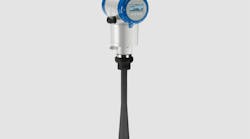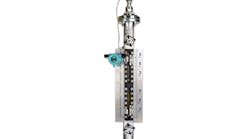Even though microbreweries produce relatively small volumes of beer, they must nonetheless overcome the same core challenges as larger manufacturers. Customers of these often independently owned facilities still expect them to deliver an increasing variety of products, all of them of a consistently high quality. Also, just like the larger breweries, production needs to be as efficient as possible to maximize throughput and profitability, while brewing methods must comply with the industry’s stringent hygiene regulations.
Implementing automation solutions can help meet these requirements and optimize production efficiency, which is essential in such a highly competitive industry. Advanced automation technology can support various stages of the brewing process, with instrumentation typically including flowmeters, density meters, pH sensors, temperature transmitters and level measurement devices.
Non-contacting radar
Having visibility into the level of product in tanks and vessels is vital for brewers as it helps to prevent product loss, maximize production capability and ensure product safety. Some organizations still depend on manual level measurements, but many have found that automated solutions provide more accurate and reliable monitoring.
Within automated level measurement solutions, non-contacting radar transmitters are widely regarded as the technology that best meets the requirement for measurement accuracy and hygienic components, while providing a wide range of further benefits. These devices are top-mounted, which reduces the risk of leakage, and because they provide continuous level measurements without touching the material surface, they have low maintenance requirements and high long-term reliability. In addition, their measurement accuracy is unaffected by process conditions such as density, viscosity, coating, vapors and changing pressure and temperature.
The more traditional use for non-contacting radar transmitters has been in large tanks or vessels — typically found in the oil, gas and petrochemical industries — to provide highly accurate level monitoring in safety-critical applications. These devices have also been applied in some food and beverage production facilities, but many microbreweries have considered them too large and costly to install and too complex to integrate into their existing automation system. In addition, some devices do not have a full range of hygienic approvals and process connections.
However, non-contacting radar level transmitters are now available that have been designed specifically for food and beverage industry applications and offer a more compact, less complex and more cost-effective solution.
Compact designs
Whereas oil and gas applications are unlikely to place demands on level measurement instrumentation in terms of footprint, the skids typically used in the food, beverage and brewing industries have tight piping arrangements, making it difficult to install large devices. To meet this challenge, the latest non-contacting radar devices use 80 gigahertz frequency modulated continuous wave technology on a single electronic chip with embedded smart algorithms. This enables the devices to be much more compact and therefore an ideal solution for the smaller tanks and space-constrained skids commonly used in the food and beverage industry.
Radar transmitters rely on reflected signals, or echoes, to perform level measurement. The latest devices use fast sweep technology to provide a continuous echo against the surface, which enables them to collect up to 40 times more information than legacy transmitters. This increases their measurement accuracy and enables brewers to reduce the amount of product lost through wastage, maximize production capability and reduce production variations, leading to increased product quality.
Maximize productivity and safety
Brewers need to maximize their production capacity to increase revenue, lower costs and keep up with customer demands. The latest non-contacting radar transmitters can perform accurate measurements all the way up to the top of the tank, with no dead zone. Eliminating dead zones makes the best use of the tank while also preventing overfills, thereby maximizing production capacity, increasing safety and reducing product loss and costs.
Every precaution must be taken to reduce the risk of contamination during the brewing process. The latest non-contacting devices have been designed so that their performance is unaffected during tank clean-in-place (CIP) and sterilize-in-place (SIP) processes. These devices have a hygienic antenna that is flush with the process connection and insensitive to condensation and buildup, ensuring the removal of process residue during CIP and SIP, and their broad range of hygienic process connections fit most common tank connections and sizes. They have a full range of hygienic approvals, ensuring they will meet the food safety standards of any brewery.
Reducing complexity is an important aim for brewers, and it is important for level measurement devices to be easy to integrate with any automation system. To achieve this, the latest device is the first non-contacting radar transmitter with IO-Link connectivity. In addition to the digital high-speed IO-Link communication, the transmitter also provides both conventional 4-20 milliamperes and switch outputs. Software configuration tools allow the devices to be connected and configured online or offline, with easy-to-use graphic interfaces decreasing commissioning time, optimizing device replacement processes and digitally recording parameter settings.
Vega Brewery application
The brewery has six fermentation tanks, where yeast is added to the wort to begin the process of turning the sugars into alcohol. A lack of visibility into the fermentation process can lead to unfavorable and inconsistent flavors that pose the risk of a contaminated batch. However, the company was running its operation without having any level measurement devices installed.
“Although we were able to operate the process by relying on the experience of our personnel in estimating the product level within the tanks, this method was prone to human error and inaccuracy and was therefore impacting the efficiency of the brewing process,” said chief brewer Ulf Eriksson. “This led us to consider the benefits we might be able to achieve by implementing an automated level measurement solution.”
Measurement challenges
The fermentation process causes foam to develop in the tanks, and excessive foaming can affect the signal strength of non-contacting radar transmitters. Some companies install agitators in their tanks to cut down the foam during fermentation, but this was not the case at Vega Brewery. Therefore, they needed a level measurement device that would perform accurately and reliably despite the presence of foam.
Another measurement challenge is presented by the presence of hops in the tanks. Hops are added to the water to produce flavor, but, during the fermentation process, solid hops can float on the surface of the liquid. This creates a slurry that can clog differential pressure devices and dampen the signal strength of radar transmitters, so Vega Brewery needed a level measurement solution that would not be affected by the hops.
In addition, the company needed to be sure that the performance of its chosen level measurement device would not be affected by the water and chemicals used in its CIP processes, as can happen with some technologies.
Simple solution
“Installing the devices was straightforward, taking less than one hour, and they proved very easy to use, which was crucial for us,” said Eriksson. “We have very little in-house automation expertise, but with minimal training our personnel were able to confidently use this solution.”
Since installation, the Rosemount 1408H transmitters have proved that they can meet the challenges presented by the presence of foam and solid hops in the fermentation tanks, and withstand the rigors of the CIP process, while still providing accurate and reliable level measurements.
“The ability to add ingredients with greater precision has enabled us to analyze and improve our processes and maximize the production capability at our plant,” said Eriksson. “Having better visibility into the tanks’ contents has also increased our operational efficiency, as it is enabling us to plan our bottling process much more effectively, in terms of knowing how long it will take and how many bottles will be required.”
The automated solution is also helping to prevent product loss and increase throughput, as the brewery no longer needs to guess when to stop the bottling process before reaching the final part of the batch that contains unwanted solid particles.
Conclusion
Continuously measuring the level of product in fermentation tanks can be challenging, but the latest non-contacting radar transmitters can meet these challenges of this application and provide an accurate and reliable solution that enables improved product quality, increased production capabilities and throughput, and reduced waste.





